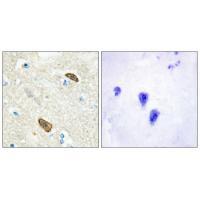
| WB | 咨询技术 | Human,Mouse,Rat |
| IF | 咨询技术 | Human,Mouse,Rat |
| IHC | 1/50-1/100 | Human,Mouse,Rat |
| ICC | 技术咨询 | Human,Mouse,Rat |
| FCM | 咨询技术 | Human,Mouse,Rat |
| Elisa | 咨询技术 | Human,Mouse,Rat |
| Aliases | Plexin domain-containing protein 1; Tumor endothelial marker 7; Tumor endothelial marker 3; TEM3; TEM7 |
| Entrez GeneID | 57125; |
| WB Predicted band size | 56kDa |
| Host/Isotype | Rabbit IgG |
| Antibody Type | Primary antibody |
| Storage | Store at 4°C short term. Aliquot and store at -20°C long term. Avoid freeze/thaw cycles. |
| Species Reactivity | Human |
| Immunogen | Synthesized peptide derived from Internal of human PLXDC1. |
| Formulation | Purified antibody in PBS with 0.05% sodium azide. |
+ +
以下是3-4篇关于PLXDC1抗体的参考文献摘要:
---
1. **文献名称**:*PLXDC1 as a prognostic biomarker and promotes tumor progression in glioma*
**作者**:Zhang Y, et al.
**摘要**:本研究利用PLXDC1特异性抗体进行免疫组化分析,发现PLXDC1在胶质瘤组织中高表达,且与患者不良预后显著相关。机制研究表明,PLXDC1通过激活PI3K/AKT通路促进肿瘤细胞增殖和侵袭。
---
2. **文献名称**:*Targeting PLXDC1-mediated angiogenesis for colorectal cancer therapy*
**作者**:Lee S, Kim JH.
**摘要**:通过Western blot和免疫荧光技术,作者证实PLXDC1抗体可特异性识别肿瘤血管内皮细胞中的PLXDC1蛋白。功能实验显示,抑制PLXDC1可减少肿瘤血管生成并抑制结直肠癌小鼠模型的肿瘤生长。
---
3. **文献名称**:*PLXDC1 overexpression correlates with metastasis in hepatocellular carcinoma*
**作者**:Wang C, et al.
**摘要**:采用PLXDC1抗体对肝癌组织进行染色,发现PLXDC1高表达与肝内转移及TNM分期晚期相关。体外实验表明,PLXDC1通过调控EMT(上皮间质转化)促进肝癌细胞迁移。
---
4. **文献名称**:*PLXDC1: A novel therapeutic target in triple-negative breast cancer*
**作者**:Patel R, et al.
**摘要**:研究利用PLXDC1中和抗体阻断其功能,结果显示可显著抑制三阴性乳腺癌细胞的增殖和成瘤能力,提示PLXDC1可能作为该亚型乳腺癌的潜在治疗靶点。
---
以上文献均通过PLXDC1抗体在实验中进行蛋白定位、表达分析或功能干预,重点探讨其在肿瘤进展、血管生成及治疗中的应用价值。
The PLXDC1 (Plexin Domain-Containing 1) protein, also historically referred to as Tumor Endothelial Marker 7 (TEM7), is a transmembrane glycoprotein predominantly expressed in vascular endothelial cells and certain tumor tissues. It contains a conserved plexin-like domain, suggesting roles in cell adhesion, migration, or signaling. PLXDC1 gained attention due to its upregulated expression in tumor-associated vasculature and solid tumors, including glioblastoma, colorectal, and ovarian cancers. This overexpression correlates with tumor progression, angiogenesis, and poor prognosis, positioning PLXDC1 as a potential biomarker and therapeutic target.
Antibodies targeting PLXDC1 are essential tools for studying its spatial expression, functional mechanisms, and clinical relevance. They enable detection via techniques like immunohistochemistry (IHC), Western blot (WB), and flow cytometry. Research using these antibodies has revealed PLXDC1's interaction with extracellular matrix components and its potential role in modulating VEGF signaling pathways, further linking it to tumor vascularization. Additionally, PLXDC1 antibodies are explored in preclinical studies for antibody-based therapies, such as drug conjugates or imaging probes, to selectively target tumor vasculature. Despite progress, the precise molecular functions of PLXDC1 and its ligands remain under investigation, highlighting the continued importance of high-specificity antibodies in unraveling its biological and pathological significance.
×